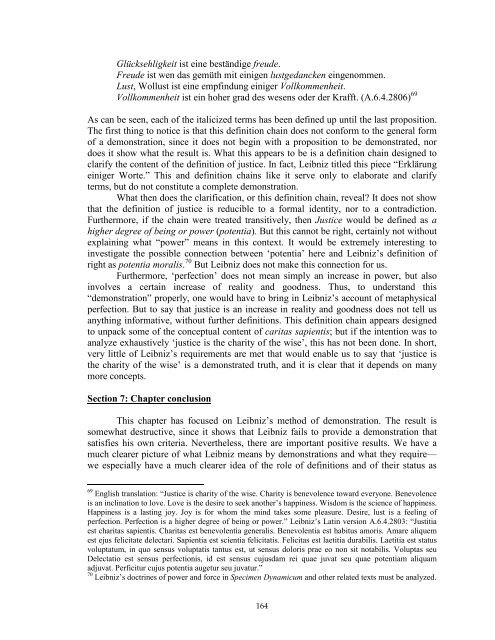Stony Brook University
Stony Brook University
Stony Brook University
You also want an ePaper? Increase the reach of your titles
YUMPU automatically turns print PDFs into web optimized ePapers that Google loves.
Glücksehligkeit ist eine beständige freude.<br />
Freude ist wen das gemüth mit einigen lustgedancken eingenommen.<br />
Lust, Wollust ist eine empfindung einiger Vollkommenheit.<br />
Vollkommenheit ist ein hoher grad des wesens oder der Krafft. (A.6.4.2806) 69<br />
As can be seen, each of the italicized terms has been defined up until the last proposition.<br />
The first thing to notice is that this definition chain does not conform to the general form<br />
of a demonstration, since it does not begin with a proposition to be demonstrated, nor<br />
does it show what the result is. What this appears to be is a definition chain designed to<br />
clarify the content of the definition of justice. In fact, Leibniz titled this piece “Erklärung<br />
einiger Worte.” This and definition chains like it serve only to elaborate and clarify<br />
terms, but do not constitute a complete demonstration.<br />
What then does the clarification, or this definition chain, reveal? It does not show<br />
that the definition of justice is reducible to a formal identity, nor to a contradiction.<br />
Furthermore, if the chain were treated transitively, then Justice would be defined as a<br />
higher degree of being or power (potentia). But this cannot be right, certainly not without<br />
explaining what “power” means in this context. It would be extremely interesting to<br />
investigate the possible connection between ‘potentia’ here and Leibniz’s definition of<br />
right as potentia moralis. 70 But Leibniz does not make this connection for us.<br />
Furthermore, ‘perfection’ does not mean simply an increase in power, but also<br />
involves a certain increase of reality and goodness. Thus, to understand this<br />
“demonstration” properly, one would have to bring in Leibniz’s account of metaphysical<br />
perfection. But to say that justice is an increase in reality and goodness does not tell us<br />
anything informative, without further definitions. This definition chain appears designed<br />
to unpack some of the conceptual content of caritas sapientis; but if the intention was to<br />
analyze exhaustively ‘justice is the charity of the wise’, this has not been done. In short,<br />
very little of Leibniz’s requirements are met that would enable us to say that ‘justice is<br />
the charity of the wise’ is a demonstrated truth, and it is clear that it depends on many<br />
more concepts.<br />
Section 7: Chapter conclusion<br />
This chapter has focused on Leibniz’s method of demonstration. The result is<br />
somewhat destructive, since it shows that Leibniz fails to provide a demonstration that<br />
satisfies his own criteria. Nevertheless, there are important positive results. We have a<br />
much clearer picture of what Leibniz means by demonstrations and what they require—<br />
we especially have a much clearer idea of the role of definitions and of their status as<br />
69 English translation: “Justice is charity of the wise. Charity is benevolence toward everyone. Benevolence<br />
is an inclination to love. Love is the desire to seek another’s happiness. Wisdom is the science of happiness.<br />
Happiness is a lasting joy. Joy is for whom the mind takes some pleasure. Desire, lust is a feeling of<br />
perfection. Perfection is a higher degree of being or power.” Leibniz’s Latin version A.6.4.2803: “Justitia<br />
est charitas sapientis. Charitas est benevolentia generalis. Benevolentia est habitus amoris. Amare aliquem<br />
est ejus felicitate delectari. Sapientia est scientia felicitatis. Felicitas est laetitia durabilis. Laetitia est status<br />
voluptatum, in quo sensus voluptatis tantus est, ut sensus doloris prae eo non sit notabilis. Voluptas seu<br />
Delectatio est sensus perfectionis, id est sensus cujusdam rei quae juvat seu quae potentiam aliquam<br />
adjuvat. Perficitur cujus potentia augetur seu juvatur.”<br />
70 Leibniz’s doctrines of power and force in Specimen Dynamicum and other related texts must be analyzed.<br />
164
















